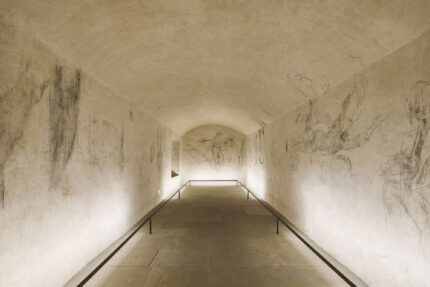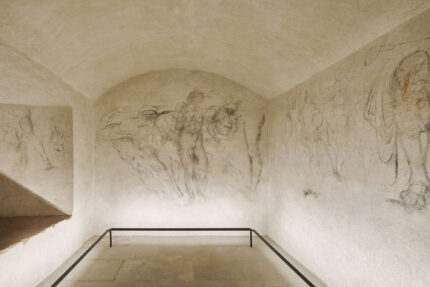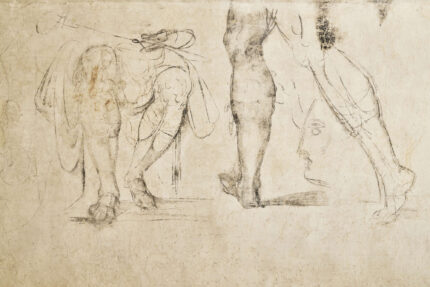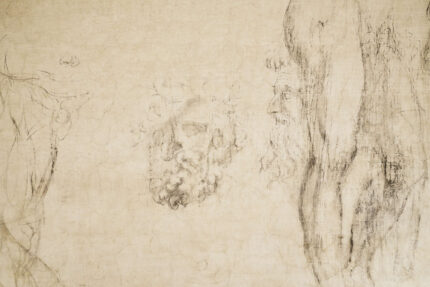 Forty-eight years after it was first discovered, the room where Michelangelo was said to have hidden from his political enemies for three months in 1530 is officially opening to the public. Whether Michelangelo actually secreted himself in the room under the New Sacristy of the Basilica of San Lorenzo until the coast was clear is unknown, but his masterful drawing is seen all over the walls.
Forty-eight years after it was first discovered, the room where Michelangelo was said to have hidden from his political enemies for three months in 1530 is officially opening to the public. Whether Michelangelo actually secreted himself in the room under the New Sacristy of the Basilica of San Lorenzo until the coast was clear is unknown, but his masterful drawing is seen all over the walls.
 The space is cramped, to say the least, at just 23 feet long, 6.5 feet wide and eight feet high at the highest point of the vault. The walls are decorated with figural studies, most of them larger-than-life-size, many of them overlapping, drawn in sticks of carbonized wood and red chalk. Subjects include the head of Laocoön from the ancient masterpiece of sculpture that Michelangelo had seen unearthed in 1506. Other figures reference sculptures and artworks by Michelangelo himself, like the legs of Giuliano de’ Medici from the marble idealized portrait Michelangelo sculpted for the tomb of Giuliano in the Medici chapel just above the secret room.
The space is cramped, to say the least, at just 23 feet long, 6.5 feet wide and eight feet high at the highest point of the vault. The walls are decorated with figural studies, most of them larger-than-life-size, many of them overlapping, drawn in sticks of carbonized wood and red chalk. Subjects include the head of Laocoön from the ancient masterpiece of sculpture that Michelangelo had seen unearthed in 1506. Other figures reference sculptures and artworks by Michelangelo himself, like the legs of Giuliano de’ Medici from the marble idealized portrait Michelangelo sculpted for the tomb of Giuliano in the Medici chapel just above the secret room.
 Michelangelo worked on the Medici mortuary chapel in the New Sacristy off and on from 1519 until his permanent move to Rome in 1534. Things only got hairy in 1527, when political upheaval after the Sack of Rome by the troops of Holy Roman Emperor Charles V spurred Florence to revolt against Medici rule and install a Republic. Michelangelo was closely involved in the Florentine Republic, appointed by the government as one of the Nine of the Militias, in charge of the fortifications of a city that was soon to be besieged by the combined forces of Spain, the Holy Roman Empire and their new ally Clement VII.
Michelangelo worked on the Medici mortuary chapel in the New Sacristy off and on from 1519 until his permanent move to Rome in 1534. Things only got hairy in 1527, when political upheaval after the Sack of Rome by the troops of Holy Roman Emperor Charles V spurred Florence to revolt against Medici rule and install a Republic. Michelangelo was closely involved in the Florentine Republic, appointed by the government as one of the Nine of the Militias, in charge of the fortifications of a city that was soon to be besieged by the combined forces of Spain, the Holy Roman Empire and their new ally Clement VII.
 The siege was protracted, lasting a grueling 10 months until Florence finally surrendered on August 10th, 1530. Michelangelo was in the cross-hairs of Clement and the Medici, now restored to power. So he hid somewhere and he was so adept at it that even his contemporary biographers could only guess at his location. He emerged in November when the Pope announced that Michelangelo would be pardoned if he went back to work on the Medici tombs in the New Sacristy. Little did Clement know Michelangelo had been steps away from it the whole time.
The siege was protracted, lasting a grueling 10 months until Florence finally surrendered on August 10th, 1530. Michelangelo was in the cross-hairs of Clement and the Medici, now restored to power. So he hid somewhere and he was so adept at it that even his contemporary biographers could only guess at his location. He emerged in November when the Pope announced that Michelangelo would be pardoned if he went back to work on the Medici tombs in the New Sacristy. Little did Clement know Michelangelo had been steps away from it the whole time.
The room, never publicly known or documented, was put to practical uses. The walls with their glorious sketches were plastered over (twice) and it was a charcoal dump until the middle of the 20th century when the trap door leading to it was covered with furniture. It was rediscovered in November of 1975 when restorers were cleaning a corridor under the New Sacristy on the hunt for a new possible exit for the Museum of the Medici Chapels.
The director of the Museum of the Medici Chapels at that time, Paolo Dal Poggetto, decided not to open the room to the public out of concern that the charcoal drawings would be damaged by exposure to crowds. Every once in a while someone pulled some strings and got a tour, but the general public has never been allowed to lay eyes on the walls before. The closest they’ve gotten is high-resolution images and video of the drawings displayed in several of Florence’s museums.
The completion of a new exit (the same one they were looking to build in 1975 when they found the room) and modern technology has made it possible to make the Secret Room accessible to the public in a controlled way. A maximum of four people at a time will be allowed into the room for reserved time slots for only 15 minutes with a maximum of 100 people per week. Conservation conditions will be scrupulously monitored and the new LED lighting, installed in 2018, will only be on for brief periods, alternating with long hours of darkness.
The room will open on November 15th for an experimental run lasting until March 30th, 2024. Tickets will cost a total of 38 euros and can be booked online here.
“The walls with their glorious sketches were plastered over (twice)….” When were the layers of plaster removed? And how did anyone know that the drawings were underneath the plaster?